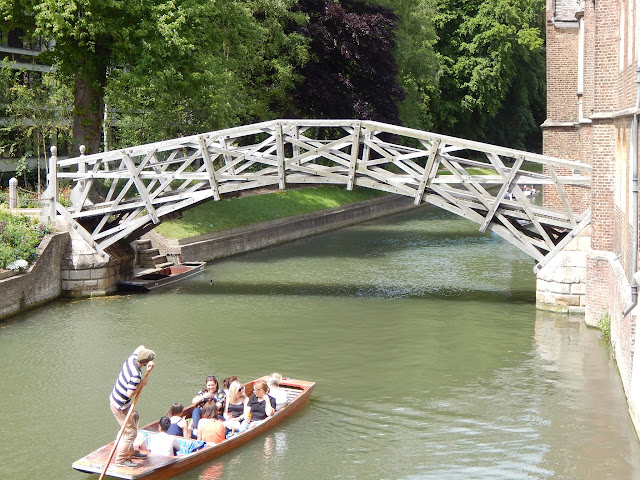Last week I posted about our trip to Madrid in late May. After Madrid, Warren, my mom and I took a night train to Lisbon, Portugal and met up with my sister and her husband. The first thing I wanted to see in Lisbon was the Church of Sao Roque, built in 1755. It is very plain on the outside but inside it is one of the most beautiful and intricate churches I've ever seen.
Inside the church are eight chapels. The one shown below is the Chapel of Our Lady of the Doctrine. It was built in the 17th century and features a wooden image of St. Anne with the Virgin Mary in her arms. The entire interior surface (including the ceiling) is made from gilt woodwork.
The Chapel of Saint John the Baptist is said to be the most expensive chapel in the world. It was built in Rome, then moved to Lisbon in 1747 and reassembled inside the Church of Sao Roque. It features four mosaic panels depicting the baptism of Christ and Pentecost. Various marbles, bronze, ornamental stones, and gilt woodwork were all used in this ornate chapel.
A lot of the buildings in Lisbon are covered in colorful tiles. I loved seeing all of the different designs and ended up bringing home a tile trivet as a souvenir.
While I was standing in the middle of the street to take the photo below, a car started coming down behind me. My sister told me to get out of the way but I thought I had plenty of time. The driver sped up (I'm really hoping it was to try to teach me a lesson for standing in the street) but didn't see that another car had their door open and got into a pretty significant accident. It sounds like she tried to blame the other driver so we gave him our information in case he needed a witness to the accident. I was not expecting anything like that to happen during our holiday!
I love different kinds of public transportation, so I was really excited to ride the funicular and trams in Lisbon. Below is one of the funiculars we rode with some interesting Pink Panther graffiti.
In 1901 the first electric tram was used in Lisbon but horse drawn trams were used since 1873. It was amazing to ride through the narrow streets and see the city from another perspective than just walking.
We spent our second day in a nearby town called Sintra. We tried this local specialty, queijadas, which have been made at the same place since 1756. It has a crisp pastry on the bottom and a marzipan-like filling made with cheese, sugar, flour, and cinnamon. We all agreed that the inside tasted similar to the inside of a brown sugar and cinnamon Pop Tart, only way better.
We toured the Sintra National Palace, a historic house which dates back to the 15th century. Many of the rooms are covered in beautiful tile patterns.
This room with the different scenes in blue tile is my favorite. The room is massive and it is completely covered in different patterns.
The dining room shown below had this incredible chandelier made of glass and a mirror to match.
The Quinta da Regaleira was the summer residence of the Carvalho Monteiro family, a very wealthy family in the late 1800s. The home sits on four hectares of land, including a wooded area and a beautiful grotto.
The room in the photo below is the hunting room. It has a massive fireplace with the statue of a woodsman, paintings of hunting scenes, and a mosaic floor of animals.
The entire property is beautiful with amazing views over the city of Sintra. Here is a photo of my mom by the main gate to the property, right next to the house.
We went straight to Belém, another town near Lisbon, with just enough time to tour the Monastery of the Hieronymites. Construction began on the monastery in 1501 and took 100 years to complete.
It was designed in a manner that later became known as Manueline which is richly ornate with complex limestone carvings.
The carvings have nautical elements, in addition to European, Moorish and Eastern motifs.
Attached to the monastery is the Church of Santa Maria. We couldn't go to the main level because they were holding a service but we were allowed to go to this second level that looks out over the massive church.
Just a little ways out from the monastery is the Tower of Belem, which is often described as "the chess piece" because of its resemblance to a rook. The tower was originally built as a fortress in 1515 to defend Lisbon's harbour.
Also in Belém is this restaurant that has the best egg tarts ever. There is typically a line out the door and around the block. When all the monasteries and convents were shut down during the liberal revolution of 1820, some people from the monastery started selling sweet pastries in order to survive. They have been making these same egg tarts ever since.
Every night we bought enough to have them for breakfast the next day. They are especially delicious with cinnamon and powdered sugar. I went absolutely crazy for these gorgeous egg tarts!
I enjoyed everything in Lisbon: the pastries, the beautiful tiled buildings, and especially the weather. This city is definitely on my list of places to go back!











































